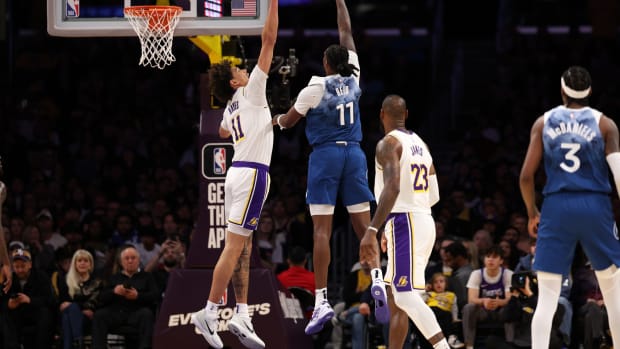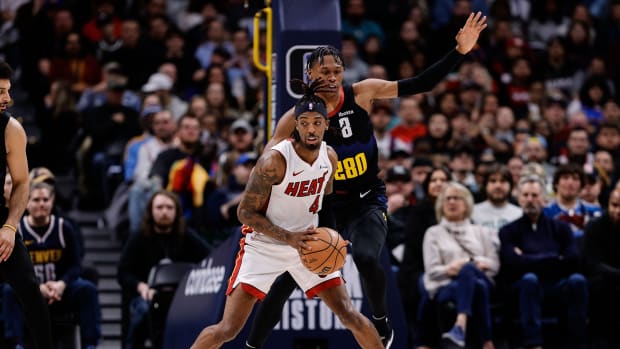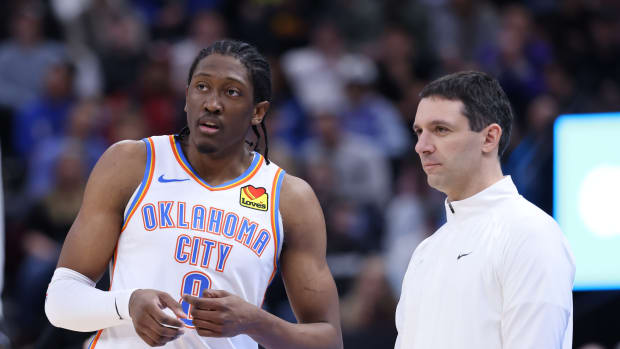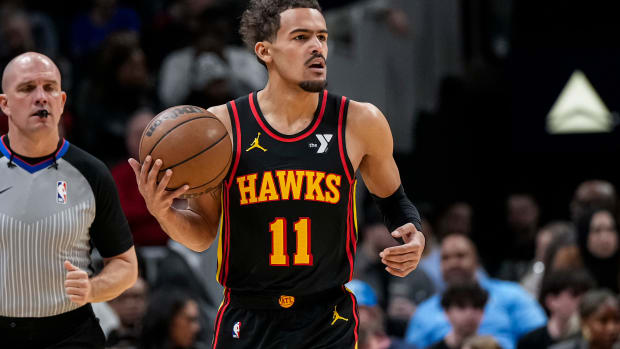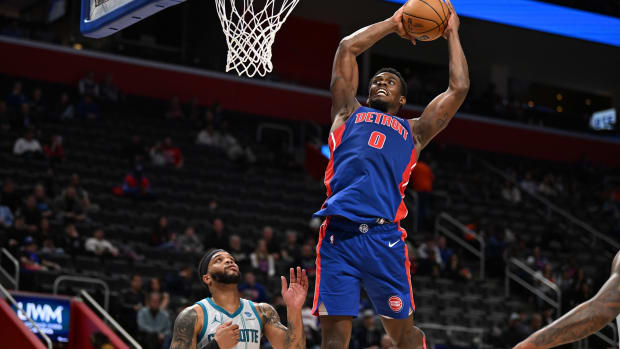How Will the Thunder Deploy Russell Westbrook and Paul George?
Somewhere deep within Russell Westbrook’s triple-double season was a call for help. Westbrook took what he could while he could, approaching his superstar positioning with a marauder mentality. Every possession was an opportunity; no one defender could really stop Westbrook, and thus his—and much of the team’s—internal calculus put the ball in his hands for wave after wave of attack. Few have worn their high usage so well. No player in the modern statistical era has posted a usage rate so high, and yet Westbrook drove ferociously into the teeth of the defense on possession after possession.
That Westbrook was so uncompromising led to one of the most gaudy individual seasons in the history of the game. It also oversimplified the Thunder offense to the point that most of Oklahoma City’s other players had been reduced to mere accessories by year’s end. Westbrook needed more support than he had for the Thunder to challenge the likes of the Warriors and the Spurs. Yet in that absence, Westbrook commanded a role so all-encompassing that it blotted out everything around him. Only a tiny subset of stars could ever have come close to the scale of what Westbrook accomplished in his MVP season. Even fewer have had the gall.
The arrival of Paul George, then, is even more a structural change than it is an acquisition of talent. Oklahoma City could have essentially run back their previous season—one in which they fielded a below-average offense and ranked just outside the bottom five of the league in effective field goal percentage. Instead, the opportunity presented itself to pair Westbrook with something close to an ideal collaborator. George is a star who doesn't dominate the ball. Even in Indiana where any better option was a consistent rarity, George still worked as a cutter and a catch-and-shoot threat. His total time of possession (3.1 minutes per game) was comparable to that of Austin Rivers or Tyler Johnson despite George averaging significantly more minutes than either. From this distance, George looks like the perfect medium: a skilled shooter and secondary creator who can give the Thunder some of what they lost in Durant’s defection without unsettling Westbrook’s new flow.
The goal isn’t to stop Westbrook from being a high-usage creator, but merely to remove the need for him to be a historically high-usage one. There will still be plenty of opportunity for Westbrook to charge headlong into the lane in a way that compromises the entire defense. George, through his curls, simply presents an alternative when the conditions aren’t quite right. For those half-court possessions when a defense can steel itself for Westbrook’s drives, an off-ball screen for George to free him up on the wing could shake something loose. The Thunder already have their proof of concept with the only other wing in the league of George’s size, ball-handling, and shooting ability:
Even having this one relatively straightforward option should bring about some meaningful expansion to the Thunder offense. Last season loading up on Westbrook became not only wise but inevitable; why treat players like Victor Oladipo or Andre Roberson as credible threats to create when even their own teammate doesn’t? It’s even more amazing in retrospect that Westbrook accomplished what he did while the lane was packed with defenders, though George should alleviate some of that degree of difficulty. George isn’t Durant, but defenses will pay him respect on the perimeter much in the same way they did KD.
Any crowding in the lane then comes at a cost. George himself might not always take the kick-out three-pointer, but one could imagine him helping open up this kind of look for new Thunder stretch-four Patrick Patterson:
And when George comes around a baseline screen as Durant does here, his momentum will weaponize that screener as a backdoor threat.
One star can command enough attention to augment a certain kind of teammate. If you’re a deadeye three-point shooter with a quick release or a lob threat with great hands, the attention Westbrook’s solo act demands can work to your benefit. It’s through multiple stars, however, that many of the league’s role players find added utility. Put Westbrook and George on the floor together and Roberson can do more than just get out of the way. Occupy a defense with George’s movement and suddenly the space clears for Stevens Adams or Enes Kanter to go to work. Patterson works especially well as a complement because of the inroads his game builds. While Oklahoma City's offense was a blunt attack last season, it can now layer its options and change directions. An entire roster can be recontextualized.
Will the Rockets' Superstar Experiment Be a Boom or Bust?
That includes Westbrook, too. Put the ball in George’s hands and some of the forgotten elements of Westbrook’s game spring to life. His post game springs to life with improved spacing and better entry angles. His backdoor cuts—all the speed and acceleration that make Westbrook so dangerous wielded against an unexpecting defense—become a regular occurrence. Oklahoma City used to run this set regularly to key up a Durant pick-and-roll for the sole purpose of finding Westbrook on the cut:
Or even more simply, a clear-out scenario for George could lull Westbrook’s defender into a fall sense of security. Even that moment’s remove can allow Westbrook to gather a lethal momentum:
All that’s left is for Westbrook, having clutched a rare level of on-court control, to let go. The last year allowed Westbrook to work almost single-mindedly; he didn’t always need to consider every possible move across a full board when his own gambit was often the best option the Thunder had. That changes through George, if not always directly. Some mental retraining will be in order. Westbrook had grown so accustomed to looking off his teammates in certain situations (some understandably, some less so) that he’ll have to work his way back toward treating them as threats. Giving Westbrook carte blanche also did no favors to his shot selection. A portion of his attempts—the premature pull-up three-pointers, in particular—ought to go. The question is whether they will quietly, if at all.
It’s important to Westbrook’s game that he press in certain situations. Not every rule of convention need apply. But make no mistake that this is a new order demanding its own calibrations, all wrapped up in the inherent stakes of George’s looming free agency. There’s so much for the new-look Thunder to explore and precious little time to get it all just right.































